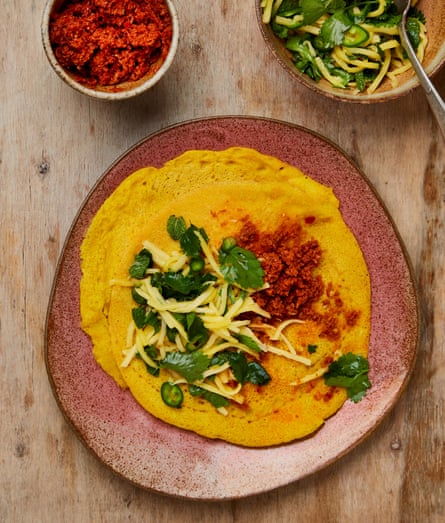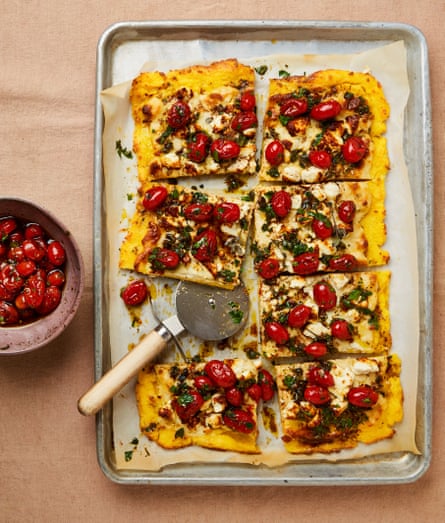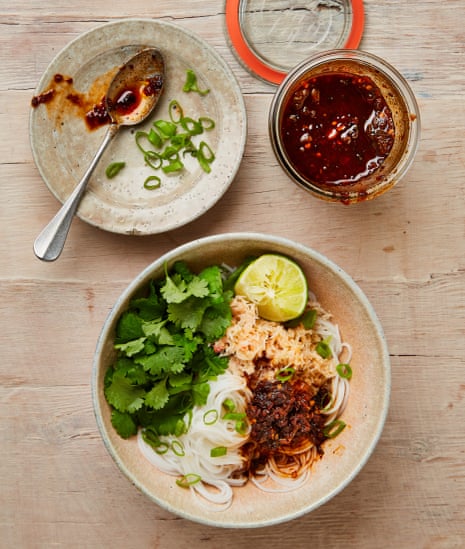The increased interest in gluten-free recipes garners strong opinions. On the one hand, coeliacs can find the confusion between them and those who have chosen a gluten-free diet frustrating (and possibly dangerous). Those who elect to go gluten-free, meanwhile – often on the grounds that they just feel much better without it – are equally baffled by the frustration (and even antipathy) that their choice inspires in others. For my part, while my diet will never be gluten-free simply for the sake of it, mealtimes are all the more interesting and varied for occasionally omitting it.
Rice noodles with lime and crab chilli oil (pictured top)
The crab chilli oil is the real star here, coating the noodles with a wonderful, spicy, seafood flavour. This makes more of the oil than you need for this dish, but it keeps in the fridge for up to a month and the flavours will intensify over time: it’s great spooned over all sorts, from egg fried rice and prawn stir-fries to roast vegetables. To avoid spoiling, just make sure the solids are always covered in oil.
Prep 10 min
Cook 40 min
Serves 2 as a main or 4 as a snack
230ml rapeseed oil, or other neutral oil
1 shallot, peeled and finely chopped (80g)
4 spring onions, trimmed and sliced into fine rounds, white and green parts kept separate
20g coriander, leaves picked, stalks finely chopped
20g piece fresh ginger, peeled and finely grated
4 garlic cloves, peeled and crushed
1 tbsp hot chilli flakes
1 tbsp tomato paste
1 tbsp white miso paste
100g brown crab meat
Flaked sea salt
¼ tsp sugar
100g rice vermicelli noodles
2 limes, 1 juiced, to get 1 tbsp, the other cut into 4 wedges
1 tsp sesame oil
100g white crab meat
Put the oil in a medium saucepand on a medium-high heat, then, once hot, fry the shallots, spring onion whites and coriander stalks for 10 minutes, until lightly coloured. Add the ginger, garlic and chilli, fry, stirring, for another minute, until fragrant, then stir in the tomato paste and miso. Turn the heat to low, stir in the brown crab meat, a quarter-teaspoon of salt and the sugar, and cook, stirring regularly and skimming off any foam that rises to the surface, for 30-35 minutes. The oil is ready when the solids are deep brown and the mix splits with the oil rising to the top.
Take off the heat, leave to cool slightly, then pour into a sterilised jar, leave to cool completely, then seal and store.
Cook the rice noodles according to the packet instructions, then drain, transfer to a bowl and toss in the lime juice, sesame oil and a half-teaspoon of flaked salt.
To serve, divide the noodles between two (or four) bowls, and arrange the white crab meat and coriander leaves to one side. Spoon over a tablespoon of the chilli oil, sprinkle some spring onion greens on top and serve with more chilli oil, the lime wedges and the rest of the spring onion greens in bowls on the side.
Spiced lentil pancakes with mango salsa and coconut chutney

These are the perfect vehicle to stuff and serve as a savoury breakfast or lunch. Make extra, if you like, and freeze them between sheets of greaseproof paper to save for a quick meal or snack at a later date.
Prep 25 min
Soak 1 hr
Cook 30 min
Makes 8 pancakes, to serve 4
For the pancake batter
225g yellow mung dal
2 garlic cloves, peeled and roughly chopped
5g piece fresh ginger, peeled and grated
1 tsp ground turmeric
Salt
4 tsp coconut oil
For the coconut chutney
2 tbsp virgin coconut oil, unmelted
1 tbsp tomato paste
50g desiccated coconut, well toasted
2-3 red chillies (40g), roughly chopped, pith and seeds removed if you prefer less heat
½ tsp lime juice
For the mango salsa
1 large green or unripe mango, halved, stoned, peeled and flesh cut into thin matchsticks (375g net weight)
2 tbsp fresh lime juice (ie, from 2 limes)
1 large mild green chilli (10g), thinly sliced, seeds and all
6½-7 tbsp (10g) roughly chopped mint leaves
2½-2¾ tbsp (10g) coriander leaves
Put the lentils in a colander and wash under cold running water until it runs clear. Tip into a medium bowl, add enough just-boiled water to cover by about 5cm, then set aside for 30 minutes to an hour (alternatively, soak the lentils overnight in cold water).
Now make the chutney. Put the oil in a small frying pan on a medium-high heat and, once hot, add the tomato paste and stir-fry for about three minutes, until lightly caramelised. Stir in the coconut to combine, then scrape into the small bowl of a food processor. Add all the other chutney ingredients and a half-teaspoon of salt, blitz until almost smooth, then transfer to a small bowl and put to one side.
Mix all the salsa ingredients and a quarter-teaspoon of salt in a small bowl and set aside.
Drain the lentils, run them under cold water again, then put in a blender with 320ml cold water and the garlic, ginger, turmeric and three-quarters of a teaspoon of salt. Blitz completely smooth, then taste and adjust the seasoning. You should end up with roughly 640g batter; if you have significantly less, top up with more cold water.
Put half a teaspoon of coconut oil in a small, nonstick frying pan on a medium-high heat and, once hot, ladle in about 80g of the batter mix and use the back of the ladle (or a spoon, if that’s easier) to spread it out to cover the base of the pan. Leave to cook for two to three minutes, until the bottom is crisp and golden and the top is almost dry, then use a spatula to lift up the edges gently and loosen the pancake from the base of the pan. Flip over, cook for a minute or two more on the other side, until golden, then transfer to a tray lined with kitchen towel. Fold the paper over to cover and keep the pancake warm while you repeat with the remaining batter and coconut oil.
To serve, distribute the pancakes between four plates, spoon over some of the chutney followed by some salsa, and eat warm or at room temperature with the remaining chutney and salsa alongside.
Baked polenta with bechamel, feta and za’atar tomatoes

This is a happy-looking pie, with its yellows and reds and wonderfully golden edges. Serve with a big green salad.
Prep 15 min
Cook 1 hr 20 min
Serves 6 as a main
80g unsalted butter
50g gluten-free plain flour
750ml whole milk
4 garlic cloves, peeled and crushed
Salt and black pepper
200g quick-cook polenta
65g pecorino, roughly grated
180g feta, roughly crumbled
5g oregano sprigs, ideally soft ones
For the za’atar tomatoes
400g small sweet ripe tomatoes, such as datterini
120ml olive oil
1½ tbsp balsamic vinegar
2 garlic cloves, peeled and crushed
2 tbsp za’atar
½ tsp caster sugar
1⅓ tbsp (5g) parsley leaves, roughly chopped
2 tbsp (5g) oregano leaves, roughly chopped
Heat the oven to 170C (150C fan)/325F/gas 3. Put the tomatoes, oil, vinegar, garlic, half a teaspoon of salt and a good grind of pepper in a roughly 27cm x 18cm baking dish. Cover tightly with foil and bake, stirring once halfway, for 40-45 minutes, until the tomatoes have just burst but haven’t completely fallen apart. Remove the foil, gently stir in the za’atar and sugar, so as not to break up the tomatoes, and leave to cool completely. Once cool, carefully stir in the herbs, again so as not to break up the tomatoes.
Turn up the oven to its highest setting – 240C (220C)/475F/gas 9 – and line a large 40cm x 30cm baking tray with greaseproof paper.
Melt 40g butter in a medium saucepan over a medium-high heat, then add the flour and whisk for 30 seconds, until it smells a bit like popcorn. Slowly pour in 350ml of the milk, whisking continuously to get rid of any lumps, then stir in the garlic, half a teaspoon of salt and plenty of pepper. Turn down the heat to medium, and cook, stirring frequently, for five minutes, until the mix is quite thick and no longer floury-tasting. Take off the heat, cover the surface of the bechamel with a piece of greaseproof paper, to prevent a skin forming, and set aside.
Meanwhile, for the polenta, put the remaining 400ml milk in a medium saute pan and add 300ml water, 20g butter, a teaspoon and a quarter of salt and a good grind of pepper. Set the pan over a medium-high heat and, once the mix starts to bubble gently, turn down the heat to medium-low and slowly pour in the polenta in a thin, steady stream, whisking continuously to incorporate. Cook, still stirring, for two minutes, until the mix thickens, then stir in the pecorino and the last 20g butter. Pour into the lined baking tray and spread out into a large rectangle about 38cm long x 1cm thick.
Spoon the cooled bechamel on top of the polenta, and spread it out with the back of the spoon so it covers most of the polenta but leaving a 1½cm rim exposed all around the edge. Top evenly with the feta and the oregano sprigs, then bake for about 25 minutes, until golden and bubbling on top and starting to brown around the edges.
Remove and leave to cool for five to 10 minutes, then spoon half the za’atar tomatoes over the top. Serve warm, cut into slabs (I use a pizza cutter), with the rest of the tomatoes in a bowl on the side.

Comments (…)
Sign in or create your Guardian account to join the discussion